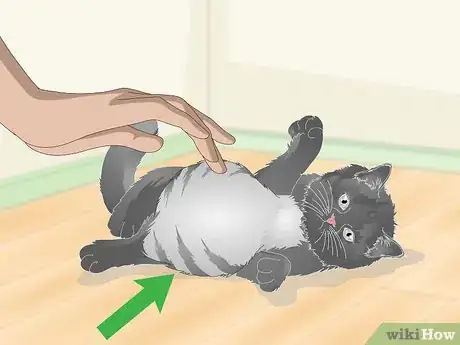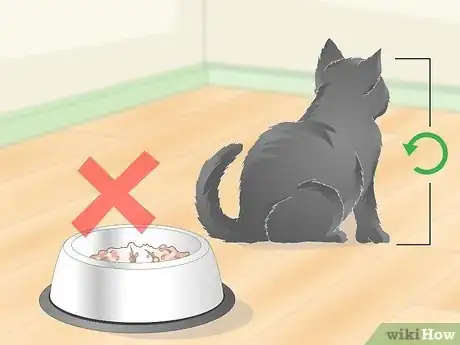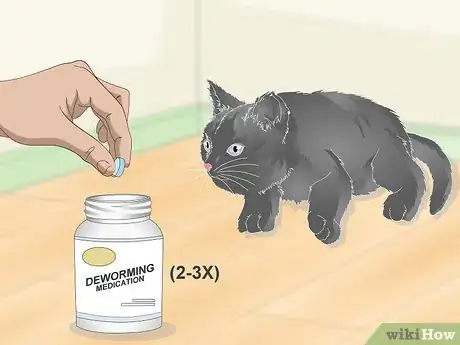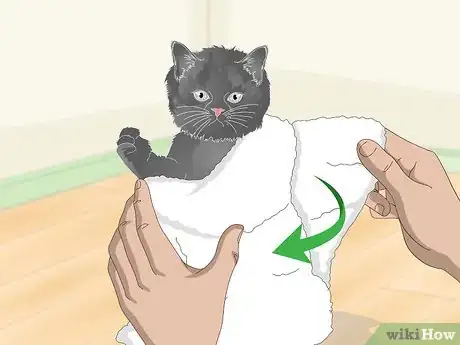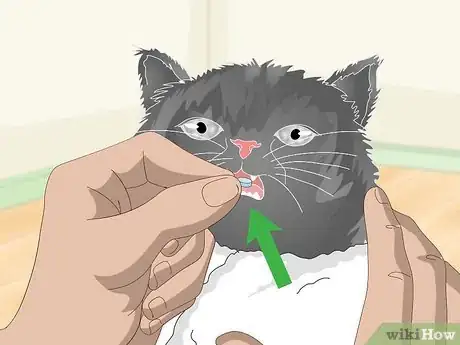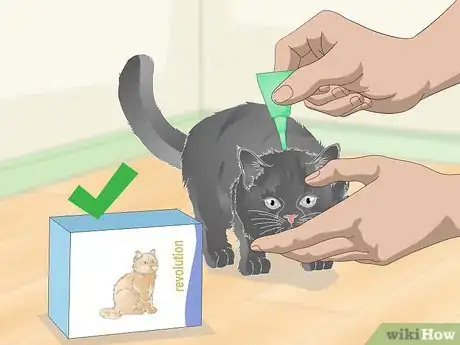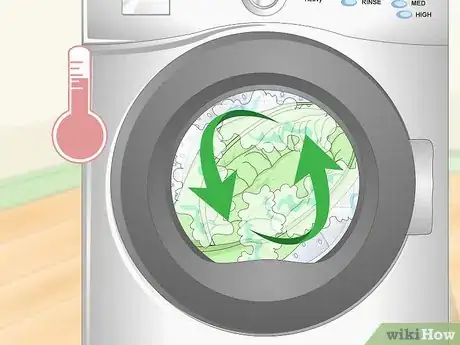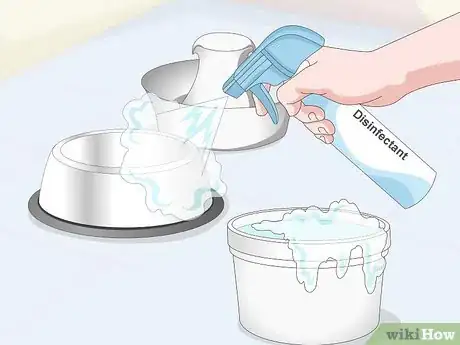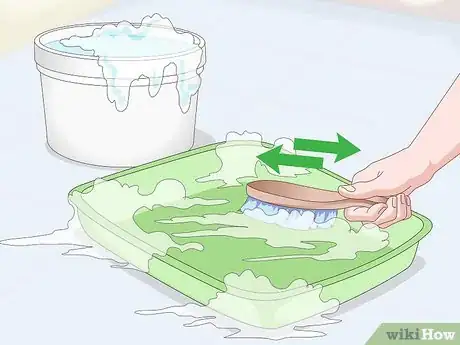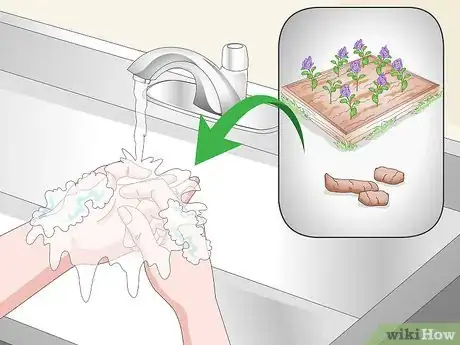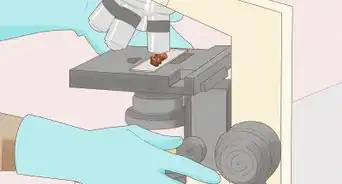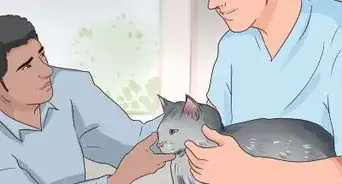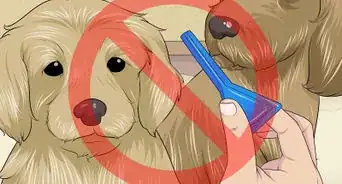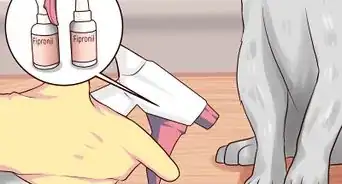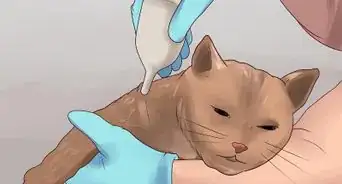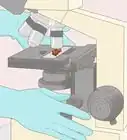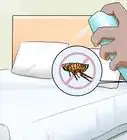This article was co-authored by Natalie Punt, DVM. Dr. Natalie Punt is a Veterinarian and the Founder and CEO of mPet- a smart phone app for pet owners to store, manage and transfer their pets medical records and health information. She specializes in small animal emergency and general medicine and veterinary practice economics. Dr. Punt holds a BS in Biochemistry and Molecular Biology from The University of California, Davis, an MS in Biochemistry from The University at Buffalo, and a DVM from Western University of Health Sciences.
There are 13 references cited in this article, which can be found at the bottom of the page.
This article has been viewed 64,260 times.
The roundworm is a common parasite that infects cats, and cats are often infected when they eat a rodent that is a carrier. It can also be passed by another cat in the feces or soil, as well as in milk from a mother to a kitten.[1] Many cats will not show any symptoms, especially early on, but you may notice an occasional roundworm in the cat's feces. You can use oral medications or a topical medication to treat the roundworms after talking with your veterinarian.
Steps
Knowing When to Go to the Vet
-
1Look for a pot-belly appearance in kittens. While all kittens will look a little round-bellied after eating, kittens with roundworm may have a potbelly for extended periods of time. Watch for a protruding belly, particularly if the kitten seems upset if you press on it.[2]
- Kittens are more likely to show symptoms than cats, but it's possible that neither will show symptoms at all.
- An adult cat may show a potbelly stomach but be thin otherwise.[3]
-
2Watch for digestive problems like vomiting and diarrhea in kittens. If your kitten is leaving puddles of vomit all over, obviously something is wrong.[4] Similarly, if your kitten suddenly starts having very wet feces, then that could also indicate roundworms.[5]Advertisement
-
3
-
4Visit the veterinarian if you suspect roundworms. Your vet is the best person to diagnose this issue. Typically, they look at a sample of stool under a microscope. The vet should be able to see roundworm eggs if they're present.[10]
- They may want you to bring in a stool sample for your cat, so call ahead.
Giving Your Cat Medications
-
1Use an oral deworming medication 2-3 times spaced 2 weeks apart. These medications, called anthelmintic medications, stun the adult roundworms, causing them to pass into your cat's stool, where they will die. However, these medications don't kill the eggs or larvae, so the treatment needs to be repeated at least a couple of times.[11]
- Talk to your vet about how often and how many times you need to give these medications. Most of these are prescription, but your vet may recommend an over-the-counter version with the active ingredient piperazine.
- Some dewormers are not suitable for young kittens. Ask your doctor if the medicine is appropriate for their age.
- Weigh your cat so you give them the correct dosage.
- If you have an outdoor cat, your vet may recommend dosing it regularly.
-
2Give your cat an oral medication by wrapping it in a towel to stabilize it. Have someone wrap the cat in a towel on a table. They should have an arm around the back of the cat to prevent its escape. Grab the cats' head just behind the eyes by wrapping your dominant hand around its head. You should feel a bone there.[12]
- Look for a dewormer with fenbendazole since it is odorless and tasteless. That way it can be mixed with wet foods so the cat doesn’t know it’s having medicine.
- You can also scruff your cat by grabbing the loose skin at the back of the neck and pulling backward. Your thumb should be between the cat's ears. This move will generally immobilize the cat.
- Some cats will take pills in the middle of a treat, like a meatball. However, make sure you don't touch the outside of the treat with the medication, as your cat will taste it.
-
3Drop the pill or liquid medication in. Gently lift the head upward, which will drop the cat's jaw down. Use your finger to go into the side of the mouth or the very front, and drop the pill into the back of the cat's mouth. Close the cat's mouth and hold it together, while you gently rub its throat and blow on its nose to get it to swallow.[13]
- It can help to tilt the cat's head back as you are trying to get it to swallow.
- If the medication is liquid, push the syringe into the side of the mouth, and unload the syringe towards the back of the mouth.
-
4Give a single dose of the topical medication Revolution instead. One topical medication, Revolution, treats roundworms in addition to other parasites like fleas, ticks, and ear mites. Typically, you will only need 1 dose of this medication, as it lasts for a month, but talk to your vet.[14]
- This medication is available through prescription only.
- To give this medication, part the fur at the back of the neck, just above the shoulder blades. Press the applicator up against the skin and release the liquid on the skin. While still squeezing, move it away from the skin, and make sure the applicator is empty.
Cleaning up after Your Cat
-
1Wash bedding in hot, soapy water. If your cat has been infected, make sure you wash its bedding, which could be contaminated with roundworm eggs. Set your washer to the highest setting, and then turn the dryer on hot, as well.[15]
- Make sure the bedding can handle being heated up that much.
-
2Disinfect your cat's food and water dishes. Scrub them out thoroughly with hot soap and water, and then use a pet-safe disinfectant on them to make sure they're clean. You can find pet-safe disinfectants online or at pet stores.[16]
-
3Clean up your cat's litter box thoroughly. If your cat has had roundworms, it could still be in its feces. Make sure to dispose of the feces so your cat and humans in your household can't get to them. Wash out the litter box with hot, soapy water, and then disinfect it with a pet-safe disinfectant.[17]
-
4Scrub your hands after being in the garden or handling the cats' feces. Roundworms can live in the soil, so if you work in the garden, make sure to scrub your hands thoroughly when you come inside. You should always wash your hands after gardening anyway, but you should pay special attention if you have a cat or you know of neighborhood cats. Similarly, always wash your hands after dealing with your cat's litter box.[18]
- Wash your hands with warm, soapy water, scrubbing for at least 20 seconds.
Warnings
- Remember to always wash your hands thoroughly after touching an infected cat or infected feces. Roundworm can be passed to humans if you ingest eggs.[19]⧼thumbs_response⧽
- Roundworms are mainly passed when a cat or kitten eats infected rodents or ingests eggs contained in feces of other cats. Kittens can get them from their mother's milk. To reduce the likelihood of your cat catching roundworms, keep it inside.[20]⧼thumbs_response⧽
References
- ↑ https://vcahospitals.com/know-your-pet/roundworm-infection-in-cats
- ↑ https://vcahospitals.com/know-your-pet/roundworm-infection-in-cats
- ↑ https://www.cats.org.uk/oxford/feature-pages/fleas--worms
- ↑ Natalie Punt, DVM. Veterinarian. Expert Interview. 14 September 2021.
- ↑ https://www2.vet.cornell.edu/departments-centers-and-institutes/cornell-feline-health-center/health-information/feline-health-topics/gastrointestinal-parasites-cats
- ↑ Natalie Punt, DVM. Veterinarian. Expert Interview. 14 September 2021.
- ↑ https://vcahospitals.com/know-your-pet/roundworm-infection-in-cats
- ↑ Natalie Punt, DVM. Veterinarian. Expert Interview. 14 September 2021.
- ↑ Natalie Punt, DVM. Veterinarian. Expert Interview. 14 September 2021.
- ↑ https://vcahospitals.com/know-your-pet/roundworm-infection-in-cats
- ↑ https://vcahospitals.com/know-your-pet/roundworm-infection-in-cats
- ↑ https://www.vetmed.wsu.edu/outreach/Pet-Health-Topics/categories/procedures/cats/giving-oral-medications-to-your-cat
- ↑ https://www.vetmed.wsu.edu/outreach/Pet-Health-Topics/categories/procedures/cats/giving-oral-medications-to-your-cat
- ↑ https://www.drugs.com/pro/revolution-topical.html#s-34067-9
- ↑ https://www.cats.org.uk/oxford/feature-pages/fleas--worms
- ↑ https://www.cats.org.uk/oxford/feature-pages/fleas--worms
- ↑ https://www.cats.org.uk/oxford/feature-pages/fleas--worms
- ↑ https://www.cdc.gov/parasites/toxocariasis/gen_info/faqs.html
- ↑ https://www2.vet.cornell.edu/departments-centers-and-institutes/cornell-feline-health-center/health-information/feline-health-topics/gastrointestinal-parasites-cats
- ↑ https://www2.vet.cornell.edu/departments-centers-and-institutes/cornell-feline-health-center/health-information/feline-health-topics/gastrointestinal-parasites-cats
